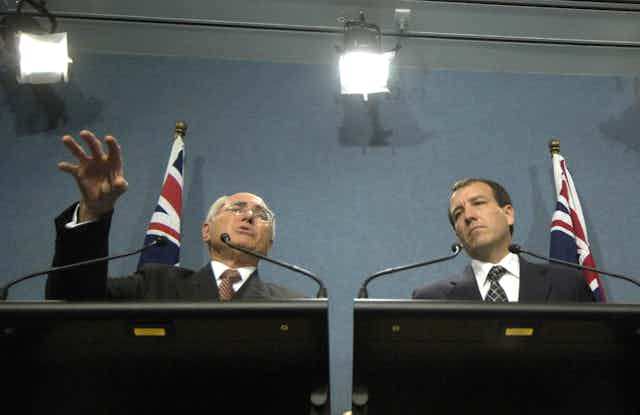Ten years ago this month, the then prime minister, John Howard, and his Indigenous affairs minister, Mal Brough, launched the Northern Territory Emergency Response (NTER) into remote Indigenous communities.
With no warning, and no consultation, the federal government moved swiftly to seize control of many aspects of the daily lives of residents in 73 targeted remote communities. It implemented coercive measures that would have been unthinkable in non-Indigenous communities.
What happened?
By deploying uniformed members of the Australian Defence Forces into the communities to establish logistics, the Intervention was designed to send a clear message of disruption and control. The government’s suspension of the Racial Discrimination Act raised further cause for concern.
Township leases were compulsorily acquired over Aboriginal-owned land by the Commonwealth for a five-year period. And the permit system administered by Aboriginal land councils to control access to Aboriginal land was revoked.
Medical teams were flown in to conduct compulsory health checks on children. Signs were posted declaring bans on alcohol and pornography in township areas.
Income management was applied to all community residents receiving welfare payments, and income support payments were linked to satisfactory school attendance.
The successful Community Development Employment Projects program was abolished, and employees were forced onto unemployment benefits. The police presence was increased in prescribed communities. And customary law was no longer allowed to be considered in bail applications and sentencing in criminal court cases.
Political implications
The trigger for the Intervention was the release of the Little Children are Sacred report. The NT government commissioned the report in response to public allegations of rampant child sexual abuse and violence in Aboriginal communities.
As in many earlier reports, the authors pointed to a range of complex social issues – including poverty, overcrowded housing, lack of educational and employment opportunities, and alcohol and substance abuse. They also emphasised the need for community-driven solutions.
The Howard government nevertheless used the report to declare a “national emergency”. The report gave the government political cover to introduce coercive and unpopular measures it had developed over the previous decade but not implemented. These included the abolition of the permit system, township leases, and welfare quarantining.
In political terms, the Howard government faced little opposition to the Intervention. Cabinet was not consulted, and the government was able to take advantage of its Senate majority to push through the legislation.
With a federal election around the corner, Labor leader Kevin Rudd saw no electoral advantage in criticising the Intervention, framed as it was in terms of deviance, dysfunction and abuse of vulnerable children. He chose to focus on other issues that had greater salience in the electorate.
Opposition from Indigenous leaders and organisations received little attention in the mainstream media. And the lack of a single co-ordinated voice following the abolition of the Aboriginal and Torres Strait Islander Commission put Indigenous opponents at a considerable disadvantage.
The NT Labor government, led by Clare Martin, was overwhelmed by the unprecedented intrusion into territory affairs. It was widely blamed for its own ineffectual response to the crisis.
Once in government, Rudd and then Julia Gillard continued all key aspects of the Intervention, and ultimately extended it for a further decade – to 2022 – in the form of Stronger Futures. Welfare quarantining, school attendance measures, and penalties for alcohol and pornography use were all expanded. This was despite a lack of evidence that these measures were effective.
The Gillard government attempted to consult with affected communities in preparing Stronger Futures. However, the consultation process was strongly criticised as inappropriate, partisan and discriminatory.
A failed experiment?
Many different bodies have evaluated the Intervention over the past decade.
Most of the policy measures were not evidence-based – and outcomes have been generally very poor. The cautious hopes for increased resources flowing into remote communities in terms of health, education and housing services have turned to disappointment.
The Intervention’s health impact has been assessed as severe. This is because of the psychological damage caused by the punitive nature of measures such as welfare quarantining, stigmatisation of community residents through links to dysfunction and child abuse, loss of autonomy, and imposition of culturally inappropriate policies.
The UN special rapporteur on human rights, James Anaya, strongly criticised the Intervention for its breaches of international human rights obligations, racially discriminatory policies, and failure to respect the rights of indigenous peoples to self-determination.
The Intervention was already recognised in 2007 as a critical moment in Indigenous affairs. The Howard government brought an end to the longstanding Commonwealth government approach of supporting Indigenous self-determination, valuing Indigenous cultural difference, and diversity of choice. It replaced it with a new paternalism, or guardianship, where “government knows best” and Indigenous difference is understood as a negative, or a deficit which must be reformed.
A decade on, the lack of engagement with Indigenous voices and knowledge in designing and implementing the Intervention has prompted renewed demands by many Indigenous people for meaningful change in the relations between First Peoples and the government. This is most evident in the debates about constitutional recognition and Indigenous policy more generally.
In the 50 years since the 1967 referendum, Indigenous affairs has been marked by many crises and panics – but rarely by substantive engagement between governments and First Peoples. A decade after the Intervention, it’s time for a new approach.
Read our accompanying piece: The NT ‘Intervention’ led to some changes in Indigenous health, but the social cost may not have been worth it

